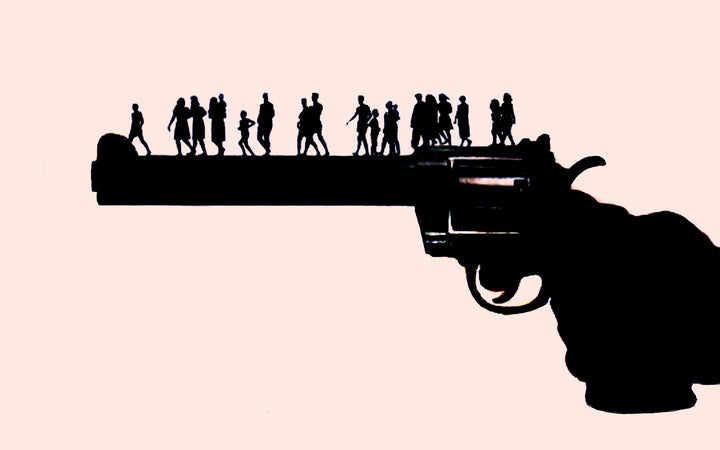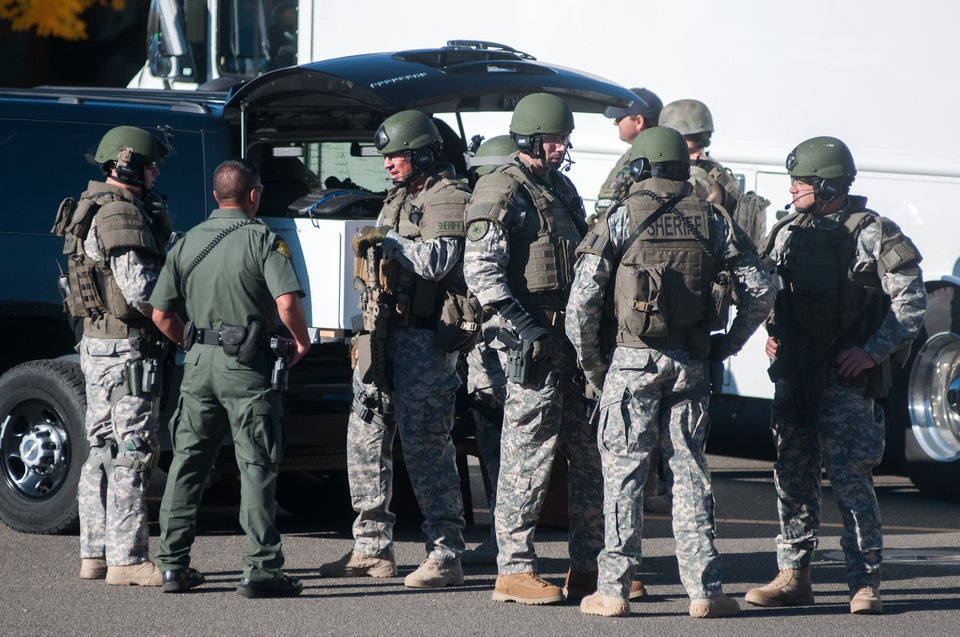
In the aftermath of yet another mass shooting in the U.S. -- the 351st in the 336 days so far this year -- a visibly weary President Barack Obama addressed the nation yet again.
"We have a pattern now of mass shootings in this country that has no parallel anywhere else in the world," he said.
This tragic, uniquely American pattern has led to cycle in which each horrific event begets more violence.
These events don't occur in a vacuum. While the "contagion" effect is well-documented in the case of suicides, it's been studied less in the context of mass shootings. But as shootings become an ever more commonplace occurrence, more of us are wondering about the possibility of a ripple effect.
We're starting to better understand the epidemiology behind this tragic trend. While the research is limited, a recent Arizona State University study found strong evidence that school shootings and other acts of mass violence are contagious.
The researchers did a statistical analysis of 176 mass shooting events in the U.S. from 2006 to 2011 and 220 school shootings between 1997 and 2013. They discovered that mass shootings were significantly more likely to occur if another shooting that received national media coverage took place in the previous 13 days -- a finding that suggests that mass shootings tend to cluster together in a similar manner to suicides. This was "apparently due to the [media] coverage planting the seeds of ideation in at-risk individuals to commit similar acts," the study said.
"People had suspected for a long time that mass killings were contagious," Sherry Towers, a research professor at Arizona State University and the study's lead author, told The Huffington Post. "Our study was the first to use to use a contagion model to quantify how much contagion there actually is in these kinds of tragedies."
Towers and her colleagues also found that states with higher rates of gun ownership had higher incidences of mass killings with firearms and school shootings. Unfortunately, their study is one of the only ones to investigate the causes of mass shootings, due to a federal ban on funding for firearms violence research.
Here's what we do and don't know about the social contagion effect of mass shootings.
Copycat Crimes
Many, if not the majority, of mass shooters researched and were inspired by past shootings, particularly the 1999 Columbine High School shooting, Towers said. Recently, authorities found out the 26-year-old perpetrator of the October shooting at Umpqua Community College in Oregon studied both the Columbine shooting and the 2011 Norway shooting in detail.
“You’d have a hard time finding someone who didn’t do some research about those who went before,” Robert Fein, a psychologist who specializes in targeted violence, recently told The New York Times.
Psychology also shows a copycat effect when it comes to violence. A famous study conducted in the early 1960s found that children learn social behaviors by watching the behavior of others. The children in the study learned to be aggressive by watching adults who behaved that way: They were particularly likely to act with aggression when they saw an adult being rewarded for behaving aggressively.
The Media's Role
National media attention may be playing a role in spreading the news about tragedies and inspiring at-risk individuals who have access to guns, Towers said.
What's more, these individuals can view the resulting media attention as a reward for violent acts.
"We need to remember that if we assign celebrity status, pay homage, glorify and sensationalize those who commit horrific crimes, we are only adding to the likelihood that similar crimes will be carried out by those craving the same attention," Richard Amaral, a counseling psychologist in Ontario, wrote in a 2013 blog post.
Knowing that their actions may garner national attention, shooters are likely using violence to seek out the spotlight. These types of crimes are "a kind of theater ... meant to be seen as an attack against society itself," Ari Schulman pointed out in The Wall Street Journal in 2013, after shootings at Los Angeles International Airport and a New Jersey mall.
"I think we're starting to realize we [the media] have sort of played a role," Dave Cullen, author of the book Columbine, told MSNBC after the Washington Navy Yard shooting in 2013. "We didn't start it. But we have sure been hurling the gasoline on, or allowing it, really gassing it up."
So what can the media do? One approach would be to implement informed, responsible reporting practices to help end the cycle of gun violence, perhaps similar to the existing media recommendations for reporting on suicide.
Some experts, along with proponents of the Anti-Notoriety Campaign and #NoNotoriety movement, have suggested that the media refrain from publishing the shooter's name or photograph.
"We should not give out the names, we should not show bloody scenes," Harris Stratyner, a clinical associate professor of psychiatry at the Mount Sinai School of Medicine, told HuffPost. "There are no simple answers, but we should stop turning these people into legends, because that's what inspires copycat crimes."
Why We Still Don't Understand
It's easy to point a finger at the media, but the issue is far more complex than that.
"There is a multifaceted problem in the U.S. that is causing this pattern of tragedies that we are consistently observing," Towers said.
Yet we don't understand the problem well, due in part to a lack of research. Since 1996, there's been a moratorium on scheduled funding for research into violence caused by firearms -- which effectively shuts down all CDC research on gun violence.
Towers and her colleagues carried out their study -- one of the few to investigate whether mass shootings are contagious -- in their spare time and without pay. That charity work is not something that most scientists would be willing to do.
Just one day before the San Bernardino shooting, former Rep. Jay Dickey (R-Ark.) wrote a letter to Congress expressing regret for authoring the bill limiting firearms violence research funding.
"It is my position that somehow or someway we should slowly but methodically fund such research until a solution is reached," Dickey wrote. "Scientific research should help answer how we can best reduce gun violence ... Doing nothing is no longer an acceptable solution."
As Dickey suggests, perhaps we don't know how to prevent these tragedies because we simply don't understand them.
"We are the only First World, industrialized country that forbids federal funding for research into firearm violence," Towers said. "People ask me, 'How can we prevent this?' The answer is, I don't know. It requires further research, but the government has put a muzzle on researchers."
Also on HuffPost:

